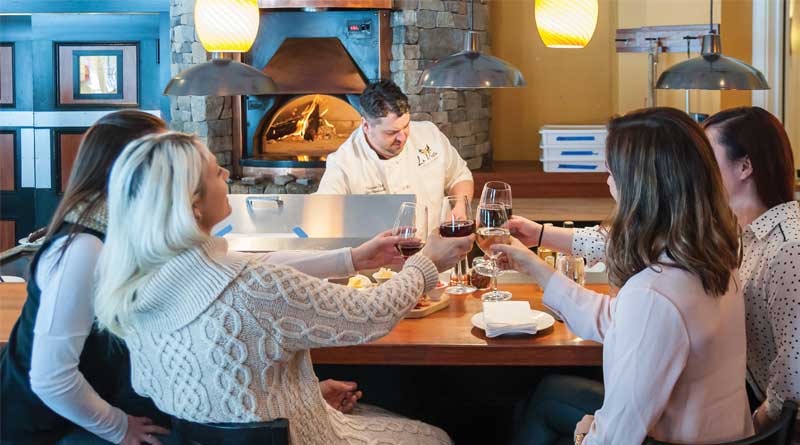Dollars from Diners: Should you DIY or Partner Up?
By Judy Kenninger
Although a key element of vacation ownership resorts’ appeal is the idea that guests can prepare their own meals in the unit’s kitchen, that doesn’t mean they want to cook every meal while on vacation. Adding food service options at your resort provides a valued amenity for guests, and it can also be an important source of ancillary revenue. According to Court Williams, CEO of HVS Executive Search, food and beverage revenues can be upwards of 50 percent of total revenue for luxury lifestyle resorts where the restaurants and bars are also a destination for guests not staying at the resort. However, he cautions, “at HVS, we believe that profit shouldn’t be the primary motive; the main reason for having food and beverage facilities in a resort is to enhance the rooms division revenue. This enables the property to offer dining facilities for guests, while the restaurant benefits from access to a continuous stream of potential diners.”
The question is, what’s the best way to maximize revenue and enhance guest satisfaction when adding a restaurant to the amenities at your resort? Here, the Resort Trades reports on two developers who have taken different approaches and weighs the pros and cons of each.
Go Your Own Way
Westgate Resorts has found success developing in-house concepts; its Edge Steakhouse at Westgate Park City Resort & Spa, Utah, resort, for example, was recently named one of USA Today’s Top Restaurants in Park City, as well as one of Forbes Magazine’s Top 12 Steakhouses in the nation. “The key is to understand the expectations of your customer, and deliver concepts that support the price point, service level and overall experience necessary to appeal to that customer,” says Mark Waltrip, COO. “We have created a variety of concepts ranging from fast food to fine dining and everything in between. Based on the resort experience and guest profile, we choose restaurant concepts that support the experience the guest is seeking, and each concept is themed to that destination. We make sure our F&B team understands that no matter what we deliver, it has to be best in class. If we’re delivering a hot dog stand, it better be the best hot dog stand in town. Likewise, if it’s one of our award-winning, fine dining steak houses, it better serve the best steak experience ever.”
The other reason Westgate keeps food service under its tight control is that even though the restaurants are profit centers, they’re a sideline to its core business. “At the end of the day we are a timeshare company first, and our timeshare sales program is based on delivering exceptional service at every guest touch point,” he says. “We never want to put ourselves (or our guests) in a situation where we don’t control that guest experience, and the last thing we would want is some third-party operator blowing up a potential sale over a $10 hamburger.”
This approach also allows Westgate to provide discounts on dining for its timeshare owners.
While owners and rental guests are the No. 1 priority, Westgate’s restaurants also attract guests from the local community. “One of our key strategies is to place our restaurants where the locals and outside guests can access them,” Waltrip says. “We also provide special parking and valet programs for locals, and special discounts during the slower seasons. Finally, we place great emphasis on using locally produced products, including craft beers, cheese and vegetable products that the local community can identify with.”
Partner Up
At Riverwalk at Loon Mountain in Lincoln, New Hampshire, (winner of ARDA’s ACE Domestic Project of Excellence Award in 2017), Dennis Ducharme and William E. “Billy” Curran, president and CEO, respectively, of InnSeason Resorts, have chosen to partner with local talent to develop their own award-winning concepts. “There’s good and bad in both approaches, but for the most part, I prefer to sublet the restaurant,” Ducharme says. “The important thing is to trust and know your restaurant partner, and to have a very well written lease.”
According to Williams, resorts can structure their agreements with restaurant operators to be a straight lease or to include revenue-sharing arrangements.
The main food service venue at Riverwalk is La Vista Italian Cuisine, which seats up to 170 when the outdoor patio is open. Cooperation makes the partnership work. “My GM and the restaurant GM hold meetings almost daily to go over occupancy and events so they can schedule the appropriate staff,” he says. “We provide a high-quality experience all around, from the food to the service to the liquor and wine menus; there’s no cutting corners. We don’t want to have any complaints.” A testimony to restaurant’s success is that about 50 percent of guests are from the local community.
According to Ducharme, the most popular meal of the day is dinner; breakfast service didn’t take off. During winter months (ski season), the resort offers a grab and go service with Danish and muffins, along with coffee and juice. “That stays pretty busy,” he says.
Another wildly successful partnership at the resort is the Seven Birches Winery located right off the lobby. “You can look through the glass and see the wine being bottled.” The winery produces 2,000 to 3,000 bottles a year; they’re mostly sold to guests. “I see few people walking out without buying a few bottles,” he says.
The wine tastings and sales have become so popular that plans now call for the winery to expand and for them to also add a small distillery.
They’re right on trend, Williams says. Today’s guests, especially Millennials, view restaurants as an important part of the overall resort concept. “It’s an important selling point because you don’t have to go anywhere,” he says. “Lifestyle hotels are all about the experience, and providing a unique food service concept makes your property one that guests will prefer.”
Foodie Trends
- In the affordable luxury and value segmented markets, quick serve and fast casual restaurants that allow the guest to place their order at a counter and then have it delivered to their table are really gaining traction. This type of restaurant brings the value of fast food with the service levels and experience of traditional sit down restaurants. We are also building Food Halls at several or our locations that give our guests multiple and completely different options, all under one roof. – Mark Waltrip, Westgate
- In urban locations, many boutique properties whose restaurants welcome the community along with in-house guests have become gathering places, where people like to come after work or for a special occasion. Having a great restaurant becomes another way to market the property. — Court Williams, HVS
- Resort guests are looking for a one of a kind experience. Watching the production of our own wine in vats and barrels right there is pretty unique, and guests enjoy the experience of wine tastings along with ordering these wines in our restaurants. – Dennis M. Ducharme, InnSeason Resorts
Judy Kenninger provides communications services to the timeshare industry and has been covering the vacation real estate industry for two decades.



